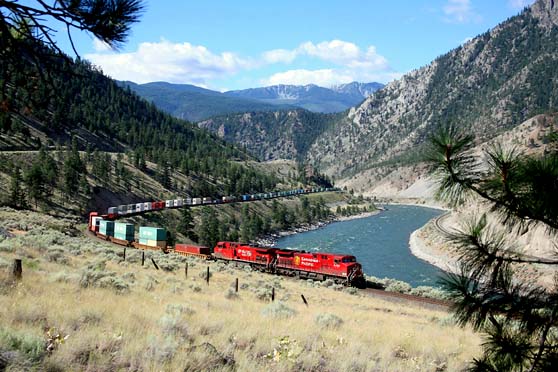
13 November 2010
Canadian Pacific Helped
Shape the Country

An eastbound double-stack container train near milepost 88 of the Thompson
Sub - 10 Jul 2006 Georg Trüb

Craigellachie British Columbia - A few days ago, Canada marked the 125th anniversary of the
driving of the Last Spike on the Canadian Pacific Railway by Donald Smith, later Lord Strathcona, at Craigellachie, B.C.
We've heard the story that goes with Canada's "most famous photo" so many times we think we know what it's about. Few have any understanding of the
extent of the enterprise and influence that sprang from the Canadian Pacific Railway Co.
A child today may see only cherry-red locomotives pulling massive trains of container cars. His or her parents may recall Canadian Pacific (now Fairmont)
Hotels, a chain of classy castles from coast to coast, and landmarks such as Vancouver's Granville Street Station, and Edmonton's Strathcona Station, now the
Iron Horse pub.
Grandparents may remember when Canadian Pacific was a player in mines and minerals, real estate, immigration, and irrigation as well as trains, ships, and
planes in a conglomerate known as the "world's greatest transportation system." Shades of this bygone glory can be seen in the Canadian Museum of
Rail Travel in Cranbrook, B.C. Yet even this is not the whole story.
Canadian Pacific laid out most of the towns and cities in the southern half of our four western provinces. It identified and promoted Canadian multiculturalism
40 years before government did.
 It pioneered global cruising. Seventy-four years before adoption of the Canadian maple leaf flag, a red-and-white flag established Canada on four oceans, a
presence captured in the slogan "Canadian Pacific Spans the World". Canadian Pacific was probably the first multinational corporation.
It pioneered global cruising. Seventy-four years before adoption of the Canadian maple leaf flag, a red-and-white flag established Canada on four oceans, a
presence captured in the slogan "Canadian Pacific Spans the World". Canadian Pacific was probably the first multinational corporation.
Canada as a transcontinental country was a byproduct of the railway, not the reverse. And the railway was the land link in the long-sought Northwest Passage
from Europe to Asia. This was what brought Italian, French, and English explorers to our shores in the first place.
Even after Samuel de Champlain founded Quebec as the seat of a thriving fur trade, the quest for the Holy Grail was not abandoned. A reward was offered and
rumours of a western sea followed up on once it was realized the land they were exploring was not the far east, but something nearer Europe, an entirely new
continent.
George-Etienne Cartier, Sir John A. Macdonald's most able lieutenant, voiced the underlying goal in a speech in support of the new venture, 274 years after
Jacques Cartier, Lachine, Que., was to be joined to its Asian namesake with the CPR as a first step.
 The railway was in fact an intermediate step, the land link or portage on the route served at either end by ship on both oceans.
The railway was in fact an intermediate step, the land link or portage on the route served at either end by ship on both oceans.
Five years after regularly scheduled transcontinental passenger service began on the CPR, the Empress of India sailed into Vancouver to inaugurate scheduled
steamship service to the Orient. She was joined by two sisters, the Empress of China, and the Empress of Japan.
Canadian Pacific had chartered steamship carriers on both coasts before the railway's completion. Now it moved to build her own fleet. By 1906, there were
Empresses on the Atlantic and Princesses on the B.C. coast. Later would come Duchesses for second-class Atlantic service and Beaver ships for cargo, making CP
a major shipowner.
At the system's peak, teas, silks, and other commodities were loaded on Pacific Empresses in Shanghai and Yokohama for an eight-to nine-day crossing to
Vancouver. At what is now Canada Place, they were transferred to trains for a four to five day transcontinental rail journey to the East Coast. Some of these
cargoes were diverted south by rail to American cities, others reloaded on ships for a five to six day Atlantic crossing. Travel time to Europe from Asia, less
than 21 days.
In a pre-air, pre-Panama Canal world, this was unmatched. No American railroad at the time ran from coast to coast or had ships operating on both oceans. Most
importantly, Canada was on the great circle route that made this intermodal, integrated system possible.
The calving off of the conglomerate into separate corporate entities, CP Hotels, CP Ships, CP Investments, and CP Rail, began in 1968. It was completed 30
years later when these divisions were spun off as separate companies to be bought, sold, and traded on the market.
The last CP Empress was sold in 1971. CP Air was sold a decade later. Scheduled passenger rail service ended when the equipment of the transcontinental
"Canadian" was sold to VIA Rail in 1979. CP Hotels, after buying competitor CN, is now independent as Fairmont Hotels.
In 1981, the last Canadian Pacific passenger ship ended service from Vancouver to Alaska, a route the CP had served 75 years. The Princess Patricia was a
6,000-ton, two-funnel pocket liner, the same size as the Empress of India, that began trans-Pacific service in 1891.
The intervening 90 years had seen a fleet of much larger ships. But the Princess Patricia had a special distinction. Under charter in the winters of 1964 and
1965, she pioneered cruising from Los Angeles to Acapulco that became the Princess Cruises, named after her.
Canadian Pacific shaped Canada, cities and towns, art and architecture, immigration and irrigation, agriculture and mining, as well as tourism, transport,
communications, and culture. But most important, it gave us the global outlook of a country not in the way, as the first China-bound explorers thought, but on
the way to where the world is going together.
David Watts.

|